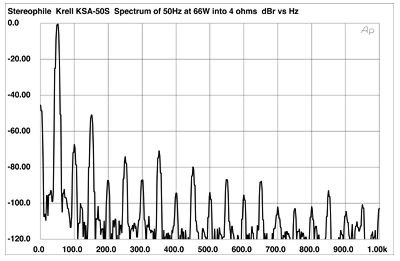| Columns Retired Columns & Blogs |
Krell KSA-50S power amplifier Measurements
Sidebar 3: Measurements
I primarily measured the Krell KSA-50S in its balanced mode. Unusually but gratifyingly, Krell provided a full set of Audio Precision measurements for the review sample. (I wish more manufacturers did this!) The '50S's two bias LEDs came on at 8 ohm output power levels of 765mW (red) and 25.2W (blue). Though the KSA-50S's heatsinks were hot following the 1/3-power, one-hour preconditioning test, I could still keep my hand on them.
The KSA-50S's input impedance measured 49k ohms unbalanced, the same for each leg of the balanced input; its output impedance was highish for a solid-state design at a calculated 0.28 ohms. This was the same at 20kHz as it was at 20Hz, however. Voltage gain into 8 ohms measured 25.75dB, balanced or unbalanced. The KSA-50S is non-inverting in the unbalanced mode; in the balanced, pin 2 is the positive leg, pin 3 the negative. The S/N ratios measured an excellent 94-95dB (unweighted, 22Hz-22kHz, inputs shorted, ref. 1W into 8 ohms), these figures improving by another 5dB when A-weighted.
Its frequency response (fig.1) was wide, dropping by just over 1dB at 200kHz. Fig.1 also shows the measured frequency response into our standard dummy load (see sidebar). The slight (+0.08dB, -0.16dB) variation is due to the interaction between the '50S's output impedance and the load. Not surprisingly, the shapes of 1kHz and 10kHz squarewaves (not shown) were textbook-perfect. The Krell's channel separation (fig.2) was also superb, that from Left to Right dropping into the amplifier's noise floor at low frequencies. It was a little asymmetrical between channels, however.

Fig.1 Krell KSA-50S, frequency response at 1W into 8 ohms, in balanced mode (top), 2W into 4 ohms (bottom), and into dummy load (top at 2kHz) (right channel dashed, 0.5dB/vertical div.).

Fig.2 Krell KSA-50S, crosstalk (from top to bottom at 2kHz): balanced R-L and L-R (10dB/vertical div.).
The Krell's distortion performance was somewhat dependent on the bias level selected: fig.3 shows the manner in which the THD+noise changes with frequency at a voltage level of 2.83V into 8, 4, and 2 ohms, and into our dummy load. Though it does rise into the lower impedances, it remains below 0.04% across the audioband. As shown in fig.4, the distortion content was predominantly third-harmonic, though other odd-order components were present, as shown in fig.5. Again, the exact mix of harmonics was somewhat dependent on signal and bias level, and on load impedance. The 1kHz difference component resulting from the amplifier being fed an equal mix of 19 and 20kHz tones remained below -68dB, even when the apparently bombproof amp was about to clip into a 4 ohm load (not shown). Impressive.

Fig.3 Krell KSA-50S, THD+noise (%) vs frequency at (from top to bottom at 20Hz): 4W into 2 ohms, 2W into 4 ohms, 2.83V into dummy load, and 1W into 8 ohms in balanced mode (right channel dashed).

Fig.4 Krell KSA-50S, 1kHz waveform at 50W into 4 ohms (top); distortion and noise waveform with fundamental notched out (bottom).

Fig.5 Krell KSA-50S, spectrum of 50Hz sinewave, DC-1kHz, at 66W into 4 ohms (linear frequency scale). Note that the third harmonic at 150Hz is the highest in level, at -50.5dB (0.3%).
Though the graphs supplied by Krell revealed a smooth increase in distortion with increasing output power, my curves (fig.6) featured some discontinuities, these coincident with the points where the bias switched. (The exact shapes of these curves were very dependent on the recent signal history and the resultant heatsink temperature.) The distortion content does rise to a few tenths of a percent when the amplifier is working hard into low impedances, but the actual clipping power—defined as 1% THD+N—is well above specification, as revealed in Table 1. My AC line voltage was rather low when I took these measurements; it is quite possible that with a higher line voltage, you will be able to squeak a full 100W into 8 ohms from this "50W" amplifier.

Fig.6 Krell KSA-50S, distortion (%) vs output power into (from bottom to top at 10W): 8 ohms, 4 ohms, and 2 ohms.
TABLE 1 Krell KSA-50S Clipping (1% THD+N at 1kHz)
| Both Channels Driven | One ChannelDriven | ||
| Load | W (dBW | W (dBW) | |
| ohms | (L) | (R) | (R) |
| 8 | 87 (19.4) | 86 (19.4) | 91.7 (19.6) |
| (line) | 112V | 112V | 113V |
| 4 | 146 (18.6) | 145 (18.6) | 160 (19.0) |
| (line) | 111V | 111V | 113V |
| 2 | 235 (17.7) | ||
| (line) | 112V | ||
Apart from the rather high static distortion levels into lower impedances, the KSA-50S features an impressive set of measurements. It's a little powerhouse of an amp!—John Atkinson
- Log in or register to post comments




































